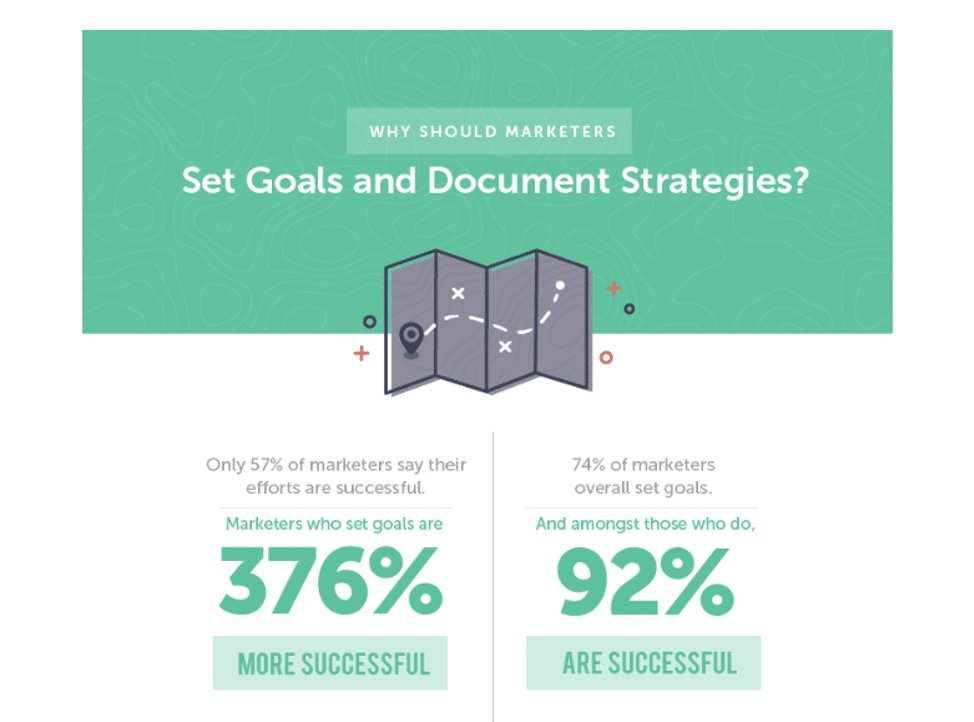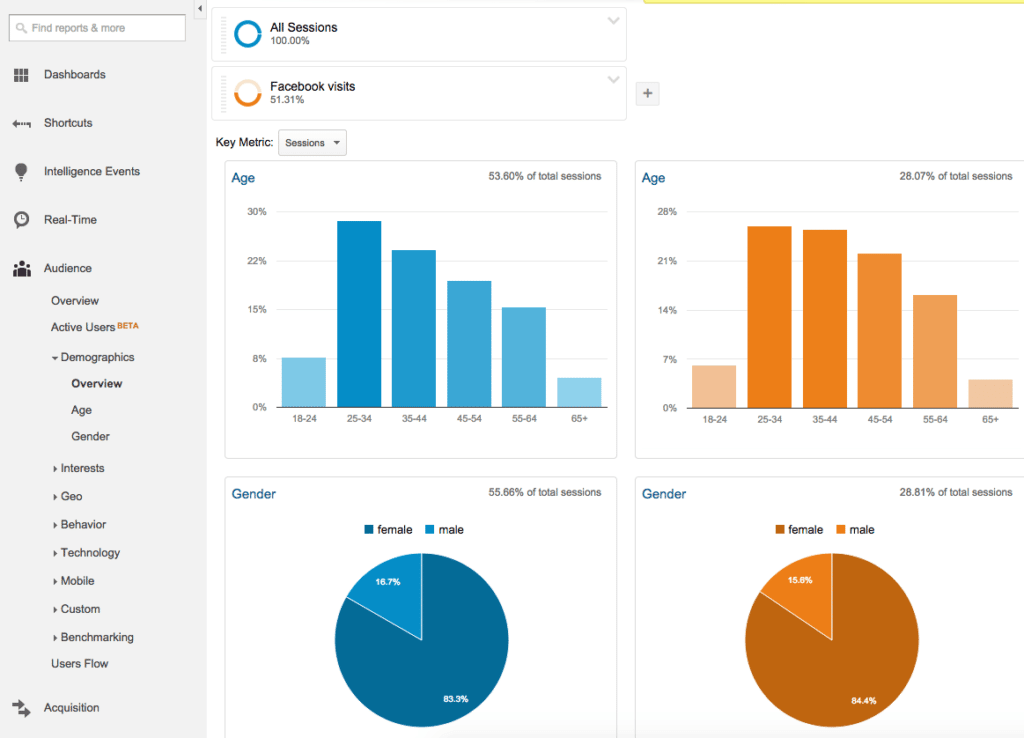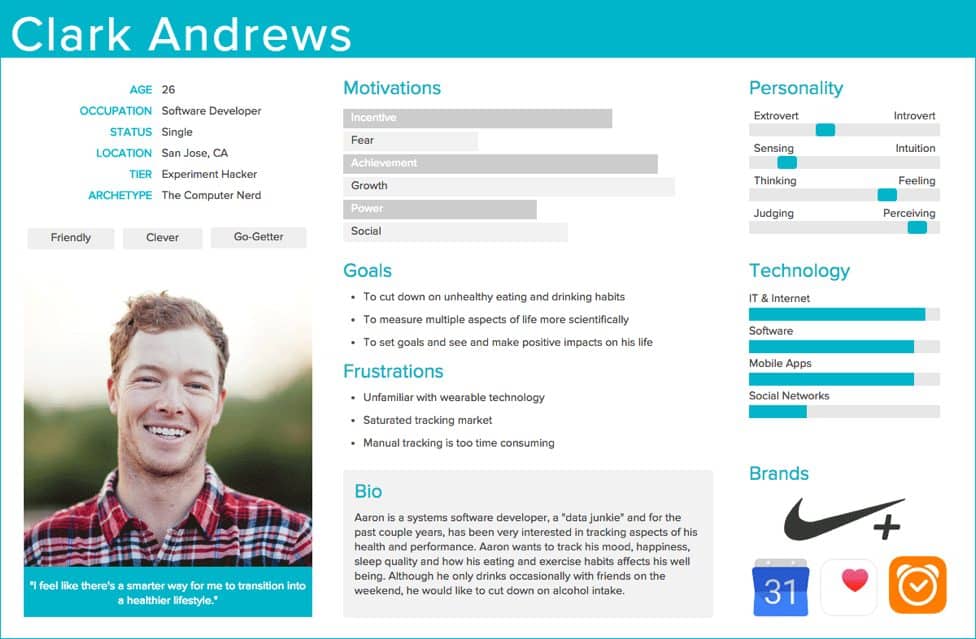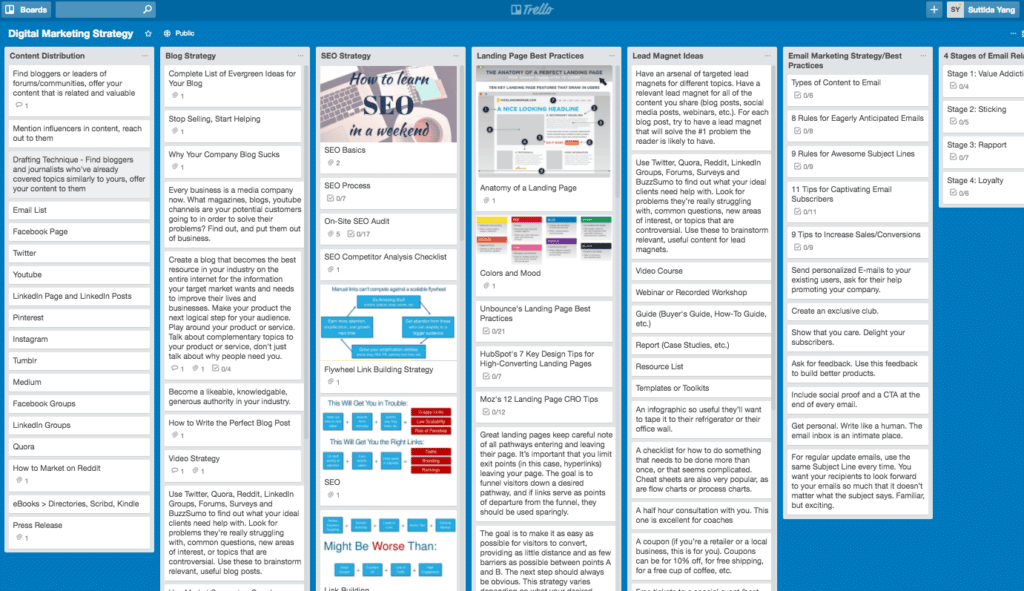Marketing isn’t a one-step journey. Simply having a plan won’t ensure you’ll make it to where you want to go. Instead, you need to pay attention to the process. You need to measure every step you take in the journey toward success.
Once you’ve developed a detailed marketing strategy, the next step is to outline a road map that will help you reach your goals.
A road map will help you mark milestones. It will help you align your marketing with your business objectives. It will keep you focused on achieving progress step by step.
So how do you create a road map that does all this? Here’s your comprehensive guide.
A Comprehensive Guide to Building a Road Map for Your Marketing Strategy
1. Set Your Goals
Marketers who have goals are 376% more likely to achieve success than those who don’t. In short, goals are essential to your marketing strategy road map.

The key is to connect your business goals with your marketing goals. Here are examples of business goals:
- Increase revenue
- Build your brand’s authority
- Reach more prospects
- Grow profits
To tie into these business objectives, here are marketing goals you can add to your road map:
- Gain more email subscribers
- Increase the number of visitors to your website
- Gain more social shares and followers
- Grow the number of click-throughs for your paid ads
Remember, set a time limit for each of these goals. For instance, if your marketing goal is to grow your email subscription to 500 emails, set a date for when you want to achieve it. A goal statement should follow this formula: (goal) plus (number) plus (date). It can look something like this: “Grow my email list to 500 in three months.”
2. Keep it Simple: Divide Marketing Aspects into Smaller Categories
After the first stage, you now have a long list of marketing goals. You want to make sure you can check all of them off at the end of the year.
The hard part is some of these goals are complex. For instance, take your marketing channels. Your business has more than one of these channels, each of which is unique. When you lump these channels together, you’ll end up confused about where to start taking your marketing game plan forward.
The secret is to break down each aspect of your marketing plan into smaller categories. Then, track each one to measure your progress.
- Your Marketing Channels. It’s important to treat each of your marketing channels separately. That way, it’ll be easier to track which ones are working and which aren’t. Here’s an example of four channels and how to track their success:
- Your website: Since your website embodies your brand’s online presence, it’s not surprising that it’s one of your major marketing channels. To keep track of its health, you can use a site audit tool like SEMRush.
- SEO and content marketing: Having evergreen content is advantageous both for SEO success and to provide readers with value. Monitor Backlinks is a helpful tool to use when tracking how well your content is ranking for keywords. And if you need more keyword ideas, SEMRush has a tool for that as well.
- Social media marketing: 96% of businesses use social media to boost their online presence and gain new leads. If social media is one of your channels, carefully measure your success by paying attention to how users engage with your brand. Do your posts get likes, comments, and shares? Are you gaining new followers?
- Email marketing: This is a powerful form of direct response copywriting. Your percentage of success with leads is much higher, as people you email have chosen to be part of your email list. So how do you track the success of this marketing channel? The best metrics include click-through rate, conversion rate, and overall ROI. I recommend using a tool like Hubspot or GetResponse to send your emails and track their effectiveness.
Other marketing channels include PPC ads, word-of-mouth marketing, SMS marketing, press releases, print ads, and webinars. No matter which ones you have chosen for your marketing strategy, the key is to measure each one separately.
Prospects in Different Stages of the Sales Funnel
The sales funnel has three distinctive levels: awareness, consideration, and decision. When dealing with your prospects, it’s a good idea to divide them based on where they are in the buying process.
- Awareness: At this stage, the chances prospects will buy from you are low. Your goal is to make them aware of you by offering them something valuable.
- Consideration: Prospects in the consideration stage recognize the value your product can bring to their lives. At this point, you want to show your expertise in your industry. You aim to show them how your brand stands above your competitors.
- Decision: This final stage is where prospects decide whether they’ll choose your product or someone else’s. It’s important to give them a final nudge and incentive to pick you over your competition.
The Lifecycle Stages of Leads
Not all leads are ready to buy from you. When you get a lead, it’s important to segregate and simplify as well.
- MQLs: These are leads who show buying potential. They have high engagement with a brand, such as multiple offer downloads and page visits. However, they aren’t ready to buy just yet.
- SQLs: SQLs are in the next stage. These leads can be qualified as customers, as they’re ready to buy your product or service.
Use Effective Metrics for Each Execution
This step is related to the one above. It’s about tracking overall success by dividing your marketing goals into different executions and then finding the right metrics to track each one.
It starts with making a list of your main marketing goals. For instance, one of your goals might be to increase your followers on social media. Another might be to convert 25% of your MQLs into SQLs.
After you’ve determined your goals, you’ll come up with your marketing KPIs (key performance indicators). These will help you determine the overall success of every aspect of your marketing goal.
Let’s look at an example.
You want to know if your blog is effective. To do this, you can assign metrics to keep track of as users engage with your blog. Here are three metrics that work.
- Bounce Rate. Bounce rate is the number of visitors who land on your site but don’t click through to other pages. If your bounce rate is low (below 70%), your content is effective and you’ve scored this metric well.
- Scroll Depth. Scroll depth is how far down the page your readers go. If you find out they’re only reading your headline and introduction before clicking the back button, you need to do something about your content. On the other hand, when your readers scroll to the very bottom of your page, your content is compelling and engaging. Best of all, it’s working.
- Time on Page. What if your readers scroll all the way to the bottom of a page without reading everything you’ve said? Maybe they find a lot of information on your blog irrelevant, but they still want to see if it answers their questions at the end. To measure this, you can look at your audience’s time on page. For instance, if it normally takes five minutes to read your blog but your readers spend only a minute on the page, they haven’t read everything you’ve written.
Taking these three metrics together will help you determine the success of every page on your site.
Create Buyer Personas for Customers
Buyer personas are essential to your marketing road map because they help every member of your team step into your customers’ shoes. When you create personas for different customers, you’ll know how to talk to them, what they’re looking for, and how you can serve them better.
Let’s take a deeper look into buyer personas and how to create them.
Buyer Personas: A Definition
Buyer personas are fictional characters who represent your company’s different prospects. Based on your potential buyers, they have different backgrounds, ages, genders, and interests.
Also, your buyers view your product differently. They have varying pain points, beliefs, and needs. It’s not hard to see how creating buyer personas helps you reach out and speak effectively to every person who’s interested in your business.
Creating buyer personas takes time and effort, but it promises you significant advantages.
Here are three benefits of buyer personas:
- Helping your customers becomes easier: The main goal of your business is to bring value to your customers’ lives. You want to provide a solution to their problems. When you have a persona, you’ll be able to understand what’s bothering them and why. Then, you can present a solution in a way that resonates deeply with them.
- You’ll be able to deliver the right content to different buyers: Depending on who your buyers are, they’ll have a unique way of speaking. Also, they’ll use channels relevant to them. Using personas will allow you to deliver content they relate to through a channel they frequently use and feel comfortable with.
- You can identify negative personas: Negative personas stand for people who will never buy from you, no matter how long you engage with them. When you create personas, you don’t waste time and money going after these people.
How to Create an Effective Buyer Persona
There’s no one way to create buyer personas that work. You’ll have to figure out what works best for you depending on how your company operates. However, these five steps can give you an idea of how to do it effectively.
Step 1: Gather General Information
How you speak to people depends on who those people are. For example, you’d use different words when giving the same news to your parents and to your friends.
Before you start working on your personas, conduct extensive research. Find out about people who have already bought your products. Basic information is important: Where do these people live? How old are they? Are they mostly men or women?
A great tool you can use is Google Analytics. With this tool, you can collect information on your website. You can find out where your visitors are from, who they are, and how long they stay on each of your pages. You can also use Organic Traffic Insights from SEMRush.

Step 2: Understand What Keeps Prospects Up at Night
Knowing where people live and what jobs they hold isn’t enough to help you create outstanding personas. You need to dig deeper and find out what’s bothering them.
When digging in deep to collect this information, remember to avoid being generic. Here’s an example of a generic vs. a specific problem.
- Generic: My life isn’t as awesome as I want it to be. This statement can be made by almost anyone you meet. But it’s simply not enough to help you create your detailed buyer persona.
- Specific: I’m living paycheck-to-paycheck and don’t have enough to save for investments and retirement. A specific problem like this helps you better understand your prospects’ pain points. With it, you’ll know which buttons to press when working to gain their attention.
But how can you find out your prospects’ main problems? The answer is to listen. Go on Amazon and search for books related to your product. Read user comments to gain insights into what makes these people feel afraid or frustrated. You can also use Quora to find similar information.
Another way to gain these insights is by conducting interviews or running online surveys. You can contact people who’ve already bought from you with an incentive to answer your questions through a call or fill in a survey. Remember, your main goal is to find out your prospects’ deepest needs.
Step 3: Identify Your Prospects’ Desires
After you’ve identified where your prospects are (the problems they’re facing), the next step is to find out where they want to be.
For instance, a person who’s worried about retirement wants to feel secure with substantial savings, insurance, and a reliable retirement plan.
A person who’s overweight wants to look and feel more attractive.
The goal is to find out what buyers want most deeply.
Step 4: Solve Buyer Problems by Focusing on Product Benefits Instead of Features
Now that you know what prospects fear and want, it’s time to introduce them to your product. This product will get them from where they are to where they want to be. The key to showing them this is to focus on product benefits instead of features.
When marketers don’t differentiate between features and benefits, their efforts to reach people fall flat.
For example, imagine you’re selling a book on a special avocado diet. If you’re focusing on features, you can go on and on about the properties of the avocado. You can list down the fatty acids, vitamins, and nutrients found in the fruit.
But people searching for a diet book aren’t interested in avocados. What they’re looking for is a way to lose 10 or 20 pounds. They want to impress their friends with their attractive figures. They want to look five years younger.
To interest them in buying your book, you focus on the benefits instead of the features of avocados. Here are some ideas:
- Avocados speed up weight loss.
- Avocados keep the heart healthy.
- Avocados promote beautiful, young-looking skin.
It’s easy to turn features into benefits. Here are some examples.
- Feature: 100 grams of avocado supplies 10% of your daily need for vitamin E.
- Benefit: You’ll look younger and have smoother, tighter skin when you eat avocados.
- Feature: 50 grams of avocado contains only 80 calories.
- Benefit: You’ll lose weight faster when you enjoy an avocado-based diet.
The next step is to match the benefits your product can provide with the pain points of your prospects.
Write this information down in your buyer persona template.
Step 5: Create Your Personas
You’ve gathered all the raw data, and now it’s time to create your personas.

First, divide all the data you’ve collected into different groups. Within each group, you’ll notice several similarities. Use these to create the fictional character who’ll represent a buyer group.
For instance, a huge group of your buyers is made up of 30-year-old women. They feel worried about aging. They spend a large portion of their income on anti-aging beauty products and healthy diet resources.
Give this character a name. For instance, you can call her Beautiful Bella. She’s 31 and single. Her main worry is looking like a dowdy old maid, so she spends time and money on spa treatments, gym membership, and beauty products.
It’s helpful to add a photo of Bella to your persona. Speaking with a real person that you know is much easier than coming up with promotions for a generic crowd of women.
Now that you know Bella on a personal level, you’ll want to help her solve her problems. Distribute Bella’s persona to your teams so marketing is consistent throughout your departments.
Don’t Be Afraid to Shift Your Implementations
Flexibility is key with marketing strategy and product road maps. It’s important not to set your marketing implementations in stone, as this could end up making you lose ground in your efforts to reach prospects.
Of course, your overall strategy shouldn’t change. However, you can allow your teams to alter how they carry out the strategy.
For example, there’s the time factor. Your marketing road map can cover months or even years. You’ll put in dates for accomplishing milestones, releasing products, and so on.
Make sure not to set these dates in stone. In a few months, your team can change. The market can shift. Feedback from prospects can take on a different tone. To match these, you’ll need to alter how you implement the goals in your marketing road map.
Release dates aren’t the only factors you’ll need to change with these shifts. You might also need to change your buyer personas, your marketing channels, and your KPIs.
The key is to stay focused on your main goals. Set these goals in stone. Aside from these, feel free to be as flexible as you can be with implementations.
Keep Every Member of Your Team Focused on the Bigger Picture
The main reason you’ve decided to create a marketing road map is that it’s easy for members of your team to get lost in the details and forget your company’s main goals.
For instance, team members can become so invested in their scheduled tasks that they lose sight of why they’re doing them in the first place. When this happens, your team won’t be able to work as one to achieve the company’s goals.
So how can you help all team members take a step back and see the bigger picture?
- Use road mapping software to make it easier for team members to get some leverage and relate their specific tasks to a main objective.
- Hold weekly meetings where you discuss new objectives, implementation changes, and so on.
- Make sure you connect these smaller details to the larger goals you set when you created your marketing road map.
Building a Marketing Strategy Road Map: Your Path to Success
Marketing your business is just like going on a trip. To call it a success, you first need to know where you’re going. Then you need to map out the whole journey, each step leading to your main goal: to enjoy your vacation.
Remember to come up with specific and measurable goals. Stick to them but stay flexible with your implementations. When you follow these steps carefully and inject passion and persistence into all your efforts, you’ll be able to stay focused on taking your company to new heights of success.







11 Responses